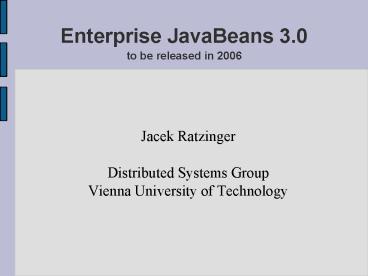Enterprise JavaBeans 3'0 to be released in 2006 PowerPoint PPT Presentation
1 / 22
Title: Enterprise JavaBeans 3'0 to be released in 2006
1
Enterprise JavaBeans 3.0to be released in 2006
- Jacek Ratzinger
- Distributed Systems Group
- Vienna University of Technology
2
Outline
- Rational for Change
- Concepts
- Annotations
- Dependency Injection
- EJB types and their specifics
- EJB-QL
- standardize Hibernate?
- Client Programming Model
- Pros and Cons
3
Rational for Change
- EJB 2.x has become overly complex
- to many artifacts for developers
- to many interfaces in EJB 2.x (home, ejb)
- unnecessary exceptions, callback methods
- no standard way to define a primary key
- EJB 3.0 makes another attempt promise reducing
EJB's complexity for developers - simpler domain models with Plain Old Java Objects
(POJOs)
4
Drive for EJB 3.0
- decrease number of artefacts
- home interfaces and deployment descriptors
- program annotations introduced in Java 5
- light-weight domain modelling
- including inheritance and polymorphism
- configuration by exception
- dependency injection
- reduction of checked exceptions
- testing outside the container
5
Java 5.0 Annotations
- annotations do not directly affect program
semantics - can be inspected through source parsing or by
using the additional reflection APIs - define custom annotations
- annotate fields, methods, classes, etc.
- used to define
- bean's business interface
- O/R mapping information (specific persistence)
- resource references
- deployment information
6
Dependency Injection
- beans may gain references to resources by having
the container supply it with those - bean instance variables or setter methods are
annotated as targets - standard way annotations
- alternatively, lookup method of
javax.ejb.EJBContext or the JNDI APIs - container responsibility before use
7
Dependency Injection
- annotation of instance variables
- _at_Resource(name"myDB") //type inferred
- public DataSource customerDB
- setter injection
- public DataSource customerDB
- _at_Resource(name myDB)
- public void setDataSource(DataSource myDB
- this. customerDB myDB
8
Specifics of EJB 3.0
- Exceptions
- interface may declare arbitrary exceptions
- should not throw java.rmi.RemoteException
- EJBException thrown by the container
- Callbacks and Callback Listener Classes
- no callbacks (e.g. ejbCreate(), ejbPassivate) for
life cycle events required - method annotations for callbacks
- callback listener class may be used instead of
callback methods
9
Entity Beans
- POJOs with annotation _at_Entity
- all fields persistent not marked with _at_Transient
(configuration by exception) - persistent once it is associated with an
EntityManager (em.persist(entity)) - approach refer with annotations to concrete
tables/columns instead of the abstract
persistence schema
10
Entity Beans
- unidirectional and bidirectional relationships
attributes of annotations - one-to-one
- one-to-many
- many-to-one
- many-to-many
- owning side responsible for propagating
relationship changes to database
11
Sample Entity Bean
- _at_Entity public class Employee
- _at_Id(generateGeneratorType.TABLE)
- public Long getId() return id
- public Address getAddress()
- return address
- _at_OneToMany(mappedByleader)
- public ListltEmployeegt getTeamMembers()
- return this.colleagues
- _at_Transient private void getFullName()
- return getFirstName()
getLastName()
12
EJB QL
- EntitiyManager API similar to Hibernate and
Toplink - persist(entity), find(Entity.class, id)
- createQuery(ejbqlString), createNativeQuery(sqlStr
ing) - EJB QL Examples
- FROM Order order
- SELECT DISTINCT order.address.state FROM Order
order WHERE order.customer.name LIKE ? - SELECT order FROM Order order INNER JOIN FETCH
order.customer
13
Enhancements to EJB QL
- explicit inner and outer join
- fetch join for eager loading (defaultlazy)
- bulk update and delete
- subqueries
- group-by
- support for native SQL queries
- dynamic query capability
14
Stateless Session Beans
- plain Java object with a class-level annotation
of _at_Stateless - can implement the javax.ejb.SessionBean
interface, but is not required to - may implement a business interface
- If no business interface implemented, generated
using all the public methods - _at_BusinessMethod by default local
- _at_Remote indicates a remote interface
15
Sample Stateless Session Bean
- import javax.ejb.
- _at_Stateless
- _at_Remote
- public class HelloWorldBean
- public String sayHello()
- return "Hello World"
16
Web Services Session Beans
- JSR-181
- a session bean that serves as a web service
endpoint is annotated with _at_WebService - _at_WebMethod used to identify methods that are
exposed as web service - other annotations
- _at_WebParam, _at_WebResult, _at_OneWay, _at_SOAPBinding,
_at_SOAPMessageHandler, _at_HandlerChain, _at_InitParam
17
Stateful Session Beans
- similar to Stateless
- lifecycle event callbacks
- _at_PostConstruct after dependency injection
- _at_PreDestroy after method with _at_Remove
- _at_PostActivate equal to ejbActivate()
- _at_PrePassivate equal to ejbPassivate()
- a callback listener class (_at_CallbackListener) may
be used instead of callback methods
18
Sample Stateful Session Bean
- _at_Stateful
- public class AccountManagementBean
- _at_EJB (name"mySessionBean") //dependency
injection - private MySessionI myBean
- private Socket socket
- _at_PostConstruct
- _at_PostActivate
- public void initRemoteConnectionToAccountS
ystem() - try
- this.socket new Socket,
PORT) - catch (Exception ex) throw new
EJBException(ex) - ...
19
Message-driven Beans
- to a client, a message-driven bean is a message
consumer - message-listener business interface determined
by the messaging type in use - javax.jms.MessageListener for JMS
20
Bean Interfaces
- session beans and message-driven beans require a
business interface - interfaces automatically generated from
implementation, if no interface implemented - interface name derived from class name
- if several interfaces implemented, annotation
required to define the business interface - interfaces assumed local unless annotated
21
Client Programming Model
- EJB 3.0 remote or local clients access beans
through their business interface - business interfaces are ordinary Java interfaces
- references to business interfaces through
- injection mechanism
- javax.ejb.EJBContext.lookup()
- JNDI API
22
Pros and Cons
- less artefacts for developers
- enterprise services for Java core (e.g.JBoss)
- EJB 3.0 compliant desktop application?
- contrary to annotations provide deployment
descriptors a holistic view to EJB modules - vendor specific annotations defeats the goal of
portability - dont forget about configuration by exception
- entity beans owning side defined by dependent
sidegt less complexity?

